Trending
Opinion: How will Project 2025 impact game developers?
The Heritage Foundation's manifesto for the possible next administration could do great harm to many, including large portions of the game development community.

Featured Blog | This community-written post highlights the best of what the game industry has to offer. Read more like it on the Game Developer Blogs or learn how to Submit Your Own Blog Post
In this 2-part post about Hero's Journey, I examine how Campbell's monomyth structure is applied to the game Journey.

This is a repost from my personal blog.
The Hero’s Journey is a narrative structure first described by Joseph Campbell in The Hero With A Thousand Faces, and later refined for modern age by Christopher Vogler in The Writer’s Journey. Campbell noticed and described patterns in our myths and stories, of the hero/heroine leaving their ordinary world to go onto adventure, and after going through trials and crises, coming back home a transformed person.
It’s a very archetypal structure that one can notice in many stories: The Lord of the Rings, Harry Potter, Star Wars, and thousands upon thousands of other works, including games. And I think why we as people are intrinsically drawn to this sort of narrative structure, is essentially because it’s about striding to a goal, facing challenges and getting to the lowest point upon the way, but eventually overcoming them and becoming a better person as a result. It’s what we encounter and go through in our daily lives, even though we might not realize it at first.
In this 2-part series of posts, I’m going to examine two games – Journey and Brothers: A Tale of Two Sons, and examine how they use The Hero’s Journey in Campbell’s and Vogler’s interpretations respectively. The reason why I chose these two particular titles, is because they use gameplay and controls themselves as a tool that helps tell the narrative, which is not something all games do. And I would argue it’s not something ALL games should do (at least, not exactly like Journey and Brothers), it’s just that due to this specificity, these particular games help us form a particular emotional connection to our avatars as we share the Hero’s Journey with them.
A fair WARNING that there will be SPOILERS. I would very much advise to play them before continuing onward. Trust me, it’s worth it.
Also, one other disclaimer – the Hero’s Journey structure is NOT a template to create good stories. It’s a tool, that one should use wisely. Even though many stories share similar narrative structure, the structure on its own is not what makes a story good.
That said, let’s begin.
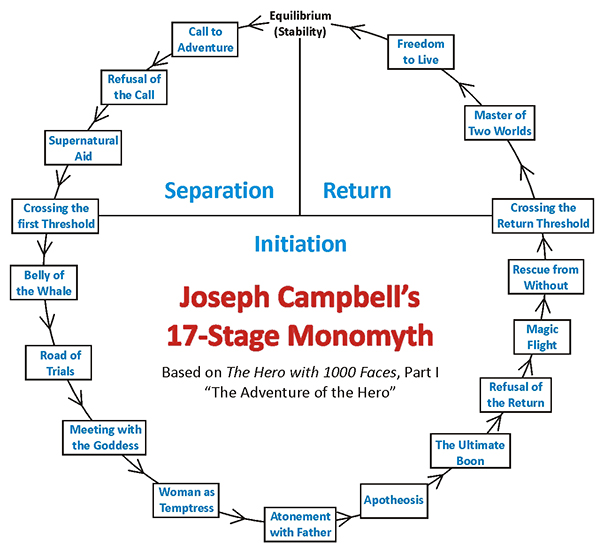
The Hero's Journey of Journey
Journey – Campbell’s Structure
Campbell’s monomyth structure has 17 stages. All steps of the Hero’s Journey can be categorized in three groups:
1. Separation – The Hero lives in his normal world, accepts the call to adventure and crosses the threshold into the special world.
2. Initiation – The Hero goes through trials, faces death, and achieves the ultimate boon.
3. Return – The Hero goes back to the ordinary world to share the boon with others.
Not every story or myth has all of the 17 stages, and they don’t all have to be in the exact order as described. As said earlier, the structure, be it Campbell’s original writings or Vogler’s reinterpretation, is a tool, not a template.
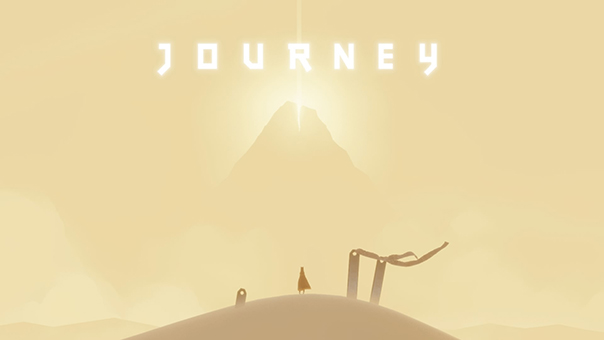
The Hero's Journey of Journey
1. Call to Adventure
The Hero starts in a status quo situation in the Ordinary World. Think Luke living on Tatooine in Star Wars, or Bilbo peacefully doing mundane Hobbit things in the Shire in The Hobbit. But then, something happens, or some information is received, that pushes the hero onto an adventure. In Star Wars, it’s Princess Leia’s message found in R2-D2, in The Hobbit – Gandalf coming to Bilbo’s front door and literally calling him to an adventure.
In Journey, we start in a barren desert with nothing to do and no points of interest. The Call to Adventure is when we see the mountain in the distance. At that moment, players know where they need to go and what their quest is.
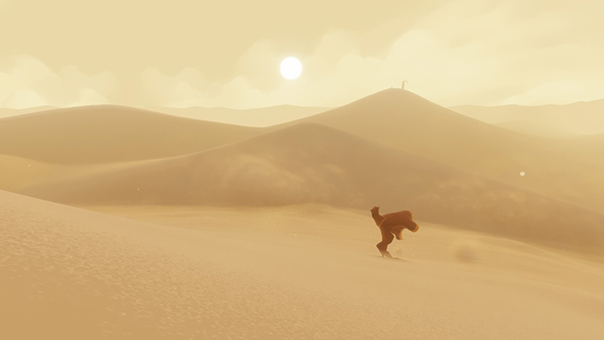
The Hero's Journey of Journey
2. Refusal of the Call
Often, after receiving the call, the Hero refuses to heed it. It might be because of fear (Bilbo) or obligations (Luke), or some other reasons, but the Hero might be reluctant to take the call. After this usually some event happens that shows the Hero why he needs to accept it, or just something/someone forcefully makes him do it.
One might say that in games this step is usually not present, in Journey as well. But this is where the connection between the player and the avatar comes in – it’s not just the avatar that can refuse the call. It’s the player as well.
In Journey, sooner or later, but this usually happens pretty close to the beginning of the game, the player gets curious – ‘What happens if I don’t go to the mountain? What if I go somewhere else?’ That’s the refusal. The player tries to go away from the goal, only to eventually be pushed back into the playable area by a supernatural wind.

The Hero's Journey of Journey
3. Supernatural Aid
Once the Hero has consciously or unconsciously committed to the quest, he meets his supernatural guide or helper, and acquires a talisman or an artifact (or several) that he will use to complete the quest. Like Bilbo getting Sting and the Ring. When it comes to the first Star Wars movie, a lot of people mention the lightsaber – but that wouldn’t be the case, as Luke never uses the lightsaber in the movie to complete the quest. The items/artifacts in possession must actually be relevant. So, Luke’s supernatural aid is Obi-Wan himself, who teaches how to use the Force.
In Journey, this is the moment when we get the scarf. It’s the remnant of our long-lost civilization (so it’s relevant world-wise) and without it we can’t complete our goal (so it’s relevant quest-wise). And our mentor is the figure in white who we talk to from time to time by using ancient monuments, that tells us the story of our people.
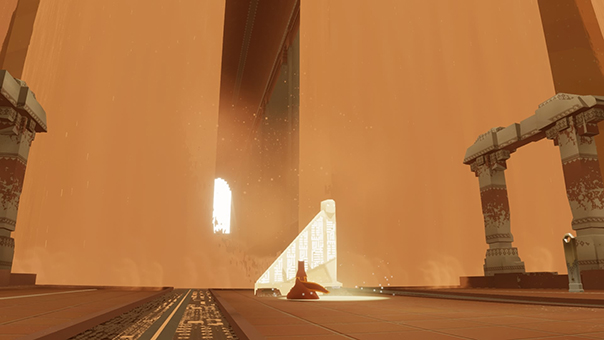
The Hero's Journey of Journey
4. Crossing the Threshold
This is the point where the Hero actually crosses into the field of adventure, leaving the known limits of his world and venturing into an unknown and dangerous realm where the rules and limits are not known. Bilbo leaving the Shire, Luke leaving Tatooine, Neo getting into the real world. Usually the Threshold signifies a point of no-return, once crossed the Hero can’t change his mind.
In Journey, it’s the location with the broken bridge, where we learn how to properly use our talisman (the scarf). We ‘rebuild’ the bridge and a literal threshold made of sand opens up. We go through it fully knowing how to use our tools and what we intend to do. This is also where the tutorial area ends.
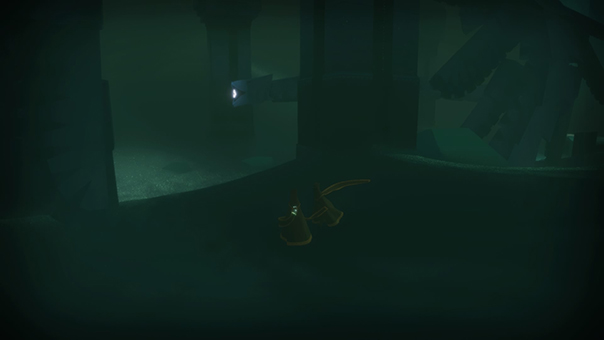
The Hero's Journey of Journey
5. Belly of the Whale
At some point after crossing the threshold, the Hero goes into a zone of great danger, usually symbolized by a descent into a subterranean location. This is where the Hero shows their willingness to undergo the metamorphosis of their character. Think Bilbo getting separated deep in the Misty Mountains, having to find courage to go through the area alone, as well as learning the nature of compassion and pity when offered an opportunity to kill Gollum.
In Journey, this is the underground part where you first encounter the Sentinel war machines built long ago by your civilization (which are also a big reason of its demise). This is where you confront and begin to understand your origins.
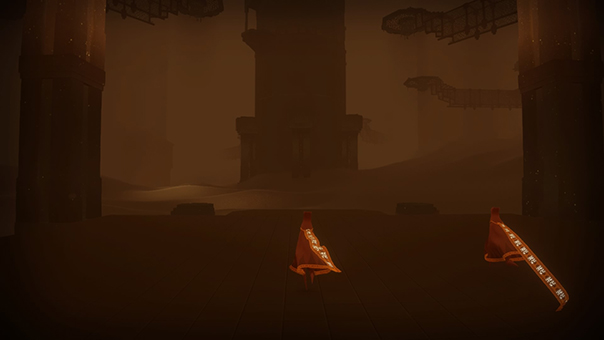
The Hero's Journey of Journey
6. The Road of Trials
The Road of Trials is a series of tests that the Hero must go through to begin his transformation. Like Luke has got his Road of Trials inside the Death Star as he tries to rescue Leia and escape. Or what happened with Bilbo in Mirkwood with the spiders and the elves and everything, where he was becoming the savior and rescuer of his group.
In Journey, the Road of Trials is the ascension to the top of the tower we get to after Belly of the Whale. It’s a literal Road of Trials. But what I absolutely adore about this location, is that we see images of our previous steps of the Hero’s Journey.
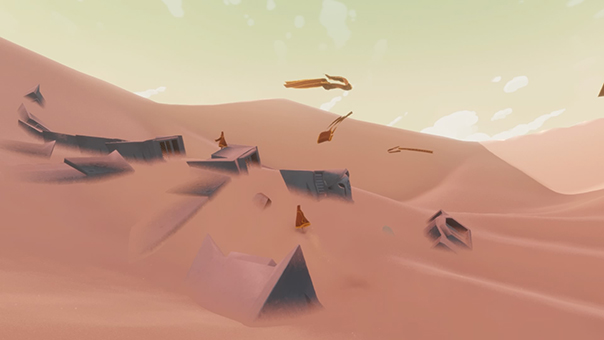
The Hero's Journey of Journey
7. Meeting with the Goddess
This is a point where the Hero encounters or experiences unconditional love that has a lot of significance. What I’ve noticed in other analyses of Journey and how Campbell’s structure is applied to it, is that most of them say this step is skipped in the game.
But, it’s not. You’ll experience it only if you’re connected online, but this step is encountering other players on your travels. In Journey, you just happen to stumble upon other people along the way, without any means to communicate with them or even knowing who they are. And the mechanics are built in such a way that you can’t hinder each other’s progress, just help.
What happens is essentially unconditional love. And the curious thing is that some players even tend to wait if their companion happens to be away from console for some time. One time I had to pause the game for 10 minutes, and when I got back, the companion was sitting beside me, patiently waiting to come back.
So in Journey this step is represented by player co-operation.
8. Woman as Temptress
To be more concrete, it’s just temptation of any form, not necessarily a woman. Basically, in this step the Hero faces temptations that may make him want to go away or abandon the quest altogether. Like Han proposing Luke to go with him instead of participating in the attack on the Death Star.
And this is once again a step that in Journey analyses is usually mentioned as being skipped. And I disagree as well. Yes, in the game proper, there’s nothing that tempts the avatar to stop the quest. But in the whole experience of Journey, where avatar and the player are very closely connected, there is. And that temptation is real world itself.
By the time the player gets to or passes the Road of Trials section, about an hour passes. Which for most people is about an average console play session time. Usually after an hour you have to turn off the game and get to business or doing necessary errands, or whatever else there can be. So you face a question of when do you continue your journey – now, later, or potentially never.
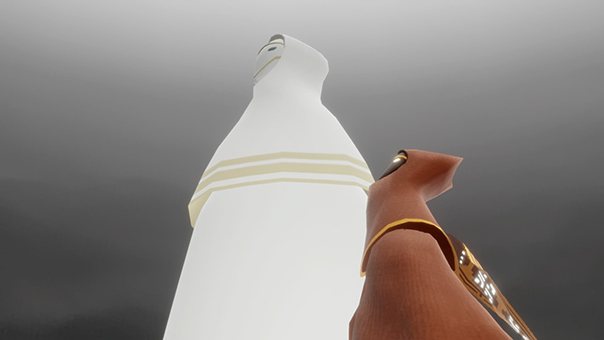
The Hero's Journey of Journey
9. Atonement with the Father
Usually considered the center point of the journey. The Hero must confront and be initiated by an entity that holds ultimate power in his life or over him. Symbolized by a ‘father’ figure a lot of the times, though really it’s just something more powerful than the Hero, approval (literal or metaphorical) of which must be achieved some way. In the Hobbit, this is Bilbo’s encounter with Smaug. By outwitting the dragon, Bilbo proves that he’s a burglar, and receives an ‘approval’.
In Journey, this is our last conversation with the white robed figure, at the end of the Road of Trials before entering the mountain. Remember how I’ve mentioned that in the Road of Trials there are images that show previous steps of our Journey? Well, in the conversation with the white robed figure, it also shows us the future step and the dangers of that final stretch to the mountain. Our avatar looks concerned, but our mentor believes in us and gives the approval (well, that’s what I gathered at least from the silent way they looked at each other :D )
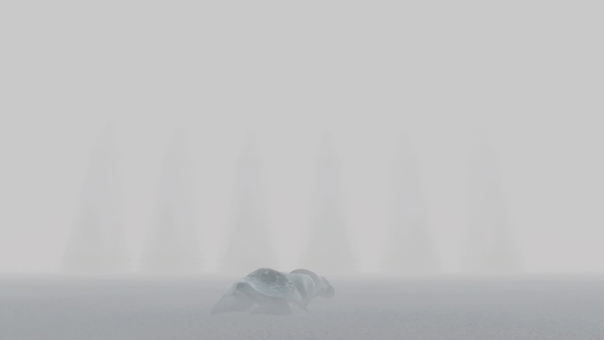
The Hero's Journey of Journey
10. Apotheosis
The Hero’s ascension to something greater than his previous self, allowing the Hero to finally achieve the goal. Usually is represented by death and rebirth. For example, in the Matrix, Neo dies, but comes back to life being able to control the Matrix. But a lot of times, the death and rebirth are metaphorical rather than literal.
In Journey, though, it is quite literal. After the hardships of climbing the mountain, our avatar dies before being able to reach the peak. Then the white-robed figures appear, giving us a second life, elevating to our full power (and a full scarf!). We fly straight into the sky.
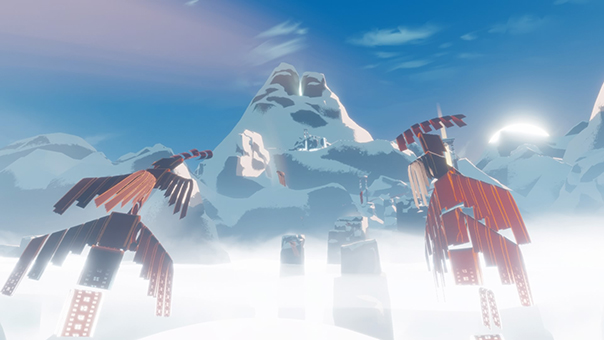
The Hero's Journey of Journey
11. The Ultimate Boon
This is the achievement of the goal of the whole quest – what the Hero has set out to do. Destroying the Death Star, for example. In Journey, this is obviously getting to the peak of the mountain. After achieving the Ultimate Boon, the Hero is ready to get back to the normal world.
12. Refusal of the Return
Or is he? After acquiring the Ultimate Boon, the Hero may want to stay in the place where they found bliss or enlightenment, not wanting to return. Like with the Refusal of the Call, this is player-centric in Journey. I myself have seen a player who had so much fun with the last location where you are pretty much free to just fly around without ever touching the ground that they didn’t seem to want to get to the end of the game. That’s the refusal of the return in Journey’s case.
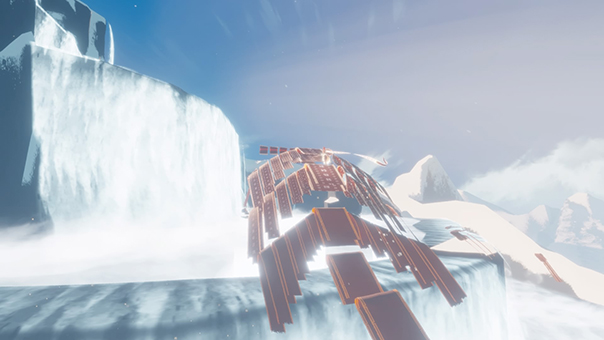
The Hero's Journey of Journey
13. Magic Flight
Sometimes the Hero must escape with the boon, or make a mad dash home, represented by a flight sequence. In Journey this has a more peaceful connotation, a literal magic flight to the threshold that will bring us back to the normal world.
14. Rescue from Without
Sometimes the Hero needs a powerful guide or entity or something to help bring them back to everyday life. This is another player-centric step in Journey. I happened to be that guide for the player I’ve mentioned previously – by drawing enough attention to myself (and trying to bump into him a bunch of times) I reminded him of what our goal is and we went to our final destination.
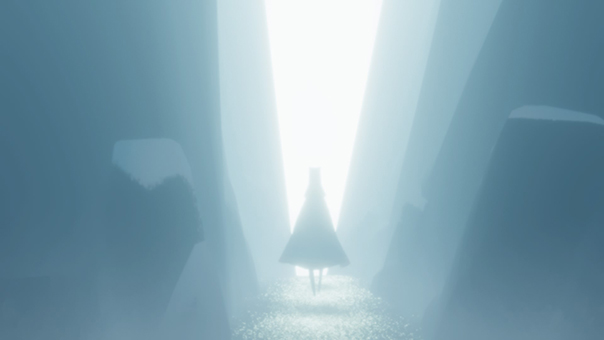
The Hero's Journey of Journey
15. Crossing the Return Threshold
A mirror of the Crossing the Threshold step, this is when the Hero leaves the special world to get back to the ordinary one. In Journey, this is when we reach the light at the peak of the mountain that transforms us into a star and sends us all the way back to the beginning location.
16. Master of Two Worlds
Despite leaving the special world, the Hero has retained all knowledge and wisdom gained there, thus becoming a Master of Two Worlds. In Journey, this is manifested by the change in our character each time we complete the game. The avatar’s robes get more embroideries and the scarf gets longer, and if we find all the secrets over the course of those playthroughs we get a white robe – symbolizing our mastery of the game.
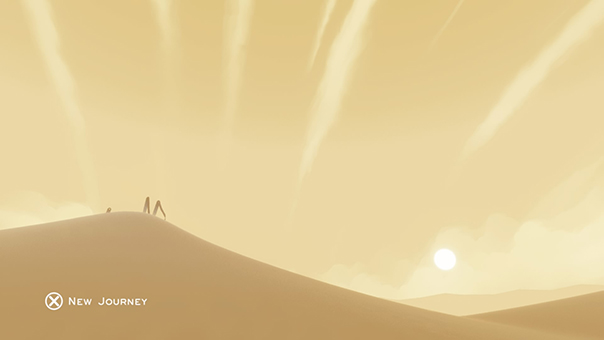
The Hero's Journey of Journey
17. Freedom to Live
Having conquered the demons and conflicts without and within and mastered the normal and special worlds, the Hero is free to choose how to live their life. In Journey, this is represented by starting a new game and guiding other players on their travels. If you want to.
So, as you can see, Journey is a perfect representation of Campbell’s monomyth structure following it to a tee, even though some of the stages can be called ‘meta’ as they might happen to the player rather than the avatar.
That said, even though Campbell’s work is a fantastic research on fairy tales and myths, I personally prefer Christopher Vogler’s reimagining of the structure Campbell has provided, and I’ll explain why, on the example of Brothers, in the next blog post on the matter.
Thank you all for reading, hope you enjoyed it. Feel free to leave any comments below. If you’d like to keep an eye on my future blog posts, feel free to follow me on Twitter
@farlander1991 :)
And if you’d like, consider supporting my work on Patreon! Thank you very much!
Read more about:
Featured BlogsYou May Also Like